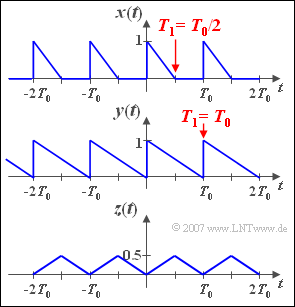Exercise 2.6: Complex Fourier Series
From LNTwww
We consider the signal $x(t)$, defined by the two parameters $T_0$ and $T_1$ where $T_1 \leq T_0$ should always apply. For the complex Fourier coefficients
- $$D_n=\frac{1}{T_0} \cdot \int_0^{T_0}x(t)\cdot\rm e^{-\rm j\it n\omega_0t}\,{\rm d} \it t$$
of this signal are obtained after mathematical transformations:
- $$D_n=\frac{T_0/T_1} {(2\pi n)^2} \cdot \bigg(1-{\rm e}^{-{\rm j} 2\pi nT_1/T_0}\bigg)-\frac{\rm j}{2\pi n}.$$
- The parameter set dealt with in subtasks (1) and (3) $($with $T_1 = T_0/2)$ is represented as the signal $x(t)$ .
- For $T_1 = T_0$ ⇒ subtask (2) the function $y(t)$ results.
- In subtask (4) the signal $z(t)$ is considered. Its Fourier coefficients are:
- $$A_0=1/4,\hspace{1cm} A_n=\left\{ \begin{array}{cl} {\frac{\displaystyle-2}{\displaystyle(\pi n)^2}} & {\rm f\ddot{u}r\; geradzahliges\; \it n \rm ,} \\ 0 & {\rm f\ddot{u}r\; ungeradzahliges\; \it n,} \end{array}\right. $$
- $$B_n=0\; \;\; \rm{ f\ddot{u}r\; alle\; \it n.}$$
Hints:
- This exercise refers to the page Complex Fourier Series.
Questions
Solution
(1) Mit dem Eulerschen Satz ist der komplexe Fourierkoeffizient $D_n$ wie folgt darstellbar:
- $${\rm Re} [D_n] =\frac{T_0/T_1}{(2\pi n)^2}\cdot(1-\cos(2\pi nT_1/T_0)),$$
- $${\rm Im}[D_n] =\frac{T_0/T_1}{(2\pi n)^2} \cdot \sin(2\pi nT_1/T_0)-\frac{1}{2\pi n}.$$
- Mit der für kleine $\alpha$-Werte gültigen Näherung $\text{sin}(\alpha ) \approx \alpha$ erhält man für den Imaginärteil:
- $${\rm Im}[D_n] =\frac{T_0/T_1}{(2\pi n)^2}\cdot(2\pi nT_1/T_0)-\frac{1}{2\pi n}=0.$$
- Für den Realteil erhält man mit $\text{cos}(\alpha) \approx 1 – \alpha^{2}/2$:
- $${\rm Re}[D_n] =\frac{T_0/T_1}{(2\pi n)^2}\frac{(2\pi nT_1/T_0)^2}{2}=\frac{T_1/T_0}{2}.$$
- Für $T_1 = T_0/2$ folgt daraus der Gleichsignalkoeffizient $D_0^{(x)} \hspace{0.1cm}\underline{= 0.25}$.
- Mit $T_1 = T_0$ ergibt sich $D_0^{(y)} = 0.5$.
- Ein Vergleich mit den Signalen $x(t)$ und $y(t)$ auf der Angabenseite zeigen die Richtigkeit dieser Ergebnisse.
(2) Es wird nun $n \neq 0$ vorausgesetzt. Mit $T_1 = T_0$ erhält man für den Realteil wegen $\text{cos}(2\pi n) = 1$:
- $${\rm Re}[D_n^{(y)}] =\frac{1}{(2\pi n)^2}\cdot(1-\cos(2\pi n))=0.$$
- Der Imagnärteil lautet:
- $${\rm Im}[D_n^{(y)}] =\frac{1}{(2\pi n)^2}\cdot(\sin(2\pi n))-\frac{1}{2\pi n}.$$
- Wegen $\text{sin}(2\pi n) = 0$ folgt daraus ${\rm Im}[D_n] =-{1}/({2\pi n}).$ Somit ist
- $$D_n^{(y)}=\frac{-\rm j}{2\pi n}={1}/{2} \cdot (A_n- {\rm j} \cdot B_n).$$
- Der Koeffizientenvergleich liefert $A_n^{(y)} = 0$ und $B_n^{(y)} = 1/(\pi n)$. Insbesondere sind $A_1^{(y)} \hspace{0.1cm}\underline{= 0}$ und $B_1^{(y)}\hspace{0.1cm}\underline{ \approx 0.318}$.
- Wie zu erwarten war, gilt stets $B_{-n}^{(y)} = -B_n^{(y)}$.
(3) Aus der in der Teilaufgabe (1) berechneten allgemeinen Gleichung folgt mit $T_1/T_0 = 1/2$:
- $$D_n^{(x)}=\frac{2}{(2\pi n)^2}(1-\cos(\pi n))+{\rm j}\cdot \left[\frac{2\sin(\pi n)}{(2\pi n)^2}-\frac{1}{(2\pi n)}\right].$$
- Daraus erhält man die Cosinuskoeffizienten
- $$A_n^{(x)}={2}\cdot{\rm Re}[D_n] =\left\{ \begin{array}{cl} {\frac{\displaystyle 2}{\displaystyle(\pi n)^2}} & {\rm f\ddot{u}r\; ungeradzahliges\; \it n ,} \\ 0 & {\rm f\ddot{u}r\; geradzahliges\;\it n.} \end{array}\right. $$
- Die Sinuskoeffizienten lauten:
- $$B_n^{(x)}=-2\cdot{\rm Im}[D_n] =\frac{1}{\pi n}.$$
- Hierbei ist berücksichtigt, dass für alle ganzzahligen Werte von $n$ die Funktion $\text{sin}(n\pi ) = 0$ ist. Die jeweils ersten reellen Koeffizienten lauten
- $$A_1^{(x)} = 2/\pi^{2} \hspace{0.1cm}\underline{\approx 0.203},$$
- $$B_1 = 1/\pi \hspace{0.1cm}\underline{\approx 0.318}.$$
(4) Richtig sind die Lösungsvorschläge 2, 4 und 5:
- Das Signal $x(t)$ ist gleich der Differenz zwischen $y(t)$ und $z(t)$. Da $z(t)$ eine gerade und $y(t)$ eine ungerade Funktion ist, werden die Cosinuskoeffizienten $A_n$ allein durch die Koeffizienten des Signals $z(t)$ bestimmt, allerdings mit negativen Vorzeichen.
- Die Sinuskoeffizienten $B_n$ stimmen vollständig mit denen von $y(t)$ überein.
- Der Gleichsignalanteil von $x(t)$ ergibt sich aus der Differenz der beiden Gleichanteile von $y(t)$ und $z(t)$:
- $$A_0 = 0.5 - 0.25 = 0.25.$$
